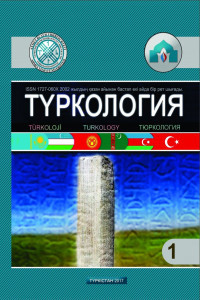SIMILIARITIES OF TURKIC OLD RUNA WRITINGS WITH KAZAKH MANUSCRIPTS
SIMILIARITIES OF TURKIC OLD RUNA WRITINGS WITH KAZAKH MANUSCRIPTS
This article deals with formation of Turkic alphabet after Chine and Shumer manuscript. The tradition belief and religion of Shumers are the same with Turkic tradition belief and religion the both nations worship to sky. Becouse shumer are from Central Asia and took with themselves Turkic manuscript was founded with the help of Turkic and Kazakh symbols
Foreign scientists who had acquired ancient manuscripts and alphabets actively worked on the research of the Turkic old Runa manuscripts. The professor of the Copenhagen university V. Thomson paid great attention to study the written manuscripts on the stones. After being familiar of the fact that the Orhon Yenisey manuscripts were the heritage of the Turkic manuscripts., he came to the conclusion that the origin of the Turkish language was closely connected with Aramei (Persian, Aramei, Sogdy).
The other group of scientists, namely N.Aristov, A.Jh.Amre, I.A.Batmanov claimed that there is not any connection between Turkic manuscript and other languages, this alphabet was affected with the Turkic symbols. However, S.E.Malov stated that Yenisey manuscript was the heritage of Kyrgyz nation. But he could not give any reliable sources.
This work deals with facts which prove that the old Runa manuscript was originated by the Turkic symbols. It was founded with the help of semiotics. Semiotics originated from Greek, meaning Symbols and signs. Semiotics is the science which studies symbols. And we came to the conclusion that old Turkic manuscripts were founded and developed in three ways:
1. Sak period;
2. Gun manuscripts;
3. Turkic manuscripts.
Keywords:
Mark, Manuscript, Turkic alphabet, Kazakh alphabet Runa manuscripts,
___
- Аманжолов А. (1996), Түркі филологиясы және жазу тарихы. Алматы: Санат, 127б.
- Бахти А. (2002), Шумеры, скифы, казахи. Алматы: «Кочевники», , 215 с.
- Бекділдаұлы Ә. Зороатуштра // Қазақ батырлары 1998, № 1.
- Быков Ф.С.(1966), Зорождение общественно-политической и философской мысли в Китае. М: Наука, 240 с.
- Гумилев Л.Н. (1994), Көне түріктер. Алматы, Білім, 502 б.
- Құдайбердіұлы Ш. Түрік, қырғыз-қазақ һәм хандар шежіресі. Алматы: Қазақстан, 1991, 200 б.
- Қазақ Совет энциклопедиясы. (1977), Алматы: 10-том, , 650 б.
- Қашқари М. (1985), Түрік сөздігі. ІІІ-том. Алматы: Жазушы, 340 б.
- Малов С.Е. (1952), Енисейская письменность тюрков. М.-Л. АНСССР., 370 с.
- Мыңжан Н. (1994). Қазақтың қысқаша тарихы. Алматы: Жалын,
- Марғұлан Ә. (1984). «Тамғалы тас» жазуы». // Жұлдыз №1.
- Өмүралыуулу Ч. (1994), Теңирчилик. Б. Крон, 286 б.
- Сартқожаұлы Қ. (2003), «Тасқа түскен тарихтың тарқатылмаған түйіні көп» // «Қазақ әдебиеті» 14. 11.
- Түркістан халықаралық энциклопедия. (2000), Алматы:, 502 б.
- Труды Орхонской экспедиции. Санкт-Петербург. 1892~1899, 210 с.
- ISSN: 1727-060X
- Başlangıç: 2002
- Yayıncı: Hoca Ahmet Yesevi Uluslararası Türk-Kazak Üniversitesi
Sayıdaki Diğer Makaleler
HİSTORİCAL LAYERS OF THE NAME ANİMALS
İLK TÜRKMEN GENERAL VE KATILDIǦI TARIHÎ OLAYLAR
Bakhytzhan NURKHANOV, Mels BAKHTYBAYEV
S.r. BORANBAEV, G. A. KOSHKAROVA, D.n. ABİEVA
THE COURSES OF THE SOLUT’ON OF THE MODERN KAZAKHS ES NATIONAL PROBLEMS
A BRIEF HISTORY OF THE CITY IN THE LIGHT SIGANAK WRITTEN SOURCES
Bakhytzhan NURKHANOV, Mels BAKHTYBAYEV
DIDACTICAL-PHILOSOPHICAL LITERATURE BY TRADITION IN THE POETRY OF ZHUSSIP YESHNIAZULY
